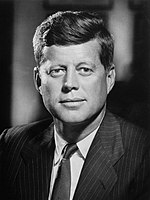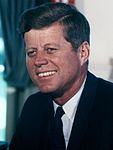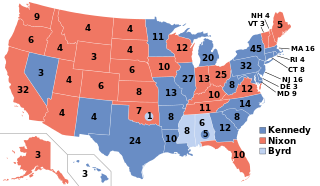
The 1960 United States presidential election was the 44th quadrennial presidential election, held on Tuesday, November 8, 1960. The Democratic ticket of Senator John F. Kennedy and his running mate, Senate Majority Leader Lyndon B. Johnson, narrowly defeated the Republican ticket of incumbent Vice President Richard Nixon and his running mate, U.N. Ambassador Henry Cabot Lodge Jr. This was the first election in which 50 states participated, marking the first participation of Alaska and Hawaii, and the last in which the District of Columbia did not. This made it the only presidential election where the threshold for victory was 269 electoral votes. It was also the first election in which an incumbent president—in this case, Dwight D. Eisenhower—was ineligible to run for a third term because of the term limits established by the 22nd Amendment.

The 1968 United States presidential election was the 46th quadrennial presidential election, held on Tuesday, November 5, 1968. The Republican nominee, former vice president Richard Nixon, defeated both the Democratic nominee, incumbent vice president Hubert Humphrey, and the American Independent Party nominee, former Alabama governor George Wallace.

The 1968 Democratic National Convention was held August 26–29 at the International Amphitheatre in Chicago, Illinois, United States. Earlier that year incumbent President Lyndon B. Johnson had announced he would not seek reelection, thus making the purpose of the convention to select a new presidential nominee for the Democratic Party. Vice President Hubert Humphrey and Senator Edmund Muskie of Maine were nominated for president and vice president, respectively.

The 2004 United States presidential election in Illinois took place on November 2, 2004, and was part of the 2004 United States presidential election. Voters chose 21 representatives, or electors to the Electoral College, who voted for president and vice president.

The Cook County Democratic Party is an American county-level political party organization which represents voters in 50 wards in the city of Chicago and 30 suburban townships of Cook County. The organization has dominated Chicago politics since the 1930s. It relies on an organizational structure of a ward or township committeeperson to elect candidates. At the height of its influence under Richard J. Daley in the 1960s when political patronage in employment was endemic in American cities, it was one of the most powerful political machines in American history. By the beginning of the 21st century the party had largely ceased to function as a machine due to the legal dismantling of the patronage system under the Shakman Decrees issued by the federal court in Chicago. The current Chair is Toni Preckwinkle, who is also the elected Cook County Board president.

The 1960 United States presidential election in California took place on November 8, 1960, as part of the 1960 United States presidential election. State voters chose 32 representatives, or electors, to the Electoral College, who voted for president and vice president.

The 1982 Illinois gubernatorial election was held in Illinois on November 2, 1982. Incumbent Republican governor James R. Thompson won a third term in office, defeating the Democratic nominee, former United States Senator Adlai Stevenson III, by a slim margin of about 5,000 votes.

The Chicago mayoral election of 1987 was first the primary election on February 24, 1987, followed by the general election on April 7, 1987. The election saw the re-election of Chicago, Illinois' first African-American mayor, Harold Washington. Ed Vrdolyak, the leader of the Vrdolyak 29, unsuccessfully opposed him, running on the Illinois Solidarity Party ticket. Former mayor Jane Byrne, who served from 1979 until 1983 unsuccessfully challenged Washington in the Democratic primary.
Benjamin S. Adamowski was a politician and lawyer.

The 1960 United States presidential election in New Jersey took place on November 8, 1960. All 50 states were part of the 1960 United States presidential election. Voters chose 16 electors to the Electoral College, which selected the president and vice president.

The 1984 United States presidential election in Illinois took place on November 6, 1984. All 50 states and the District of Columbia, were part of the 1984 United States presidential election. State voters chose 24 electors to the Electoral College, which selected the president and vice president of the United States.

The 1980 United States presidential election in Illinois took place on November 4, 1980. All 50 states and The District of Columbia, were part of the 1980 United States presidential election. State voters chose 26 electors to the Electoral College, who voted for president and vice president. Illinois voters chose between the Democratic ticket of incumbent president Jimmy Carter and vice president Walter Mondale, and the Republican ticket of Ronald Reagan and running mate George H. W. Bush, as well as the independent candidacy of John B. Anderson and running mate Patrick Lucey.

The 1976 United States presidential election in Illinois was held on November 2, 1976. All 50 states and The District of Columbia, were part of the 1976 United States presidential election. State voters chose 26 electors to the Electoral College, who voted for president and vice president.
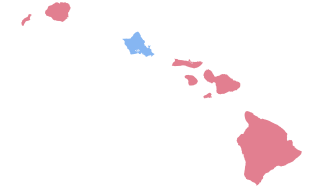
The 1960 presidential election in Hawaii was held on November 8, 1960, as part of the 1960 United States presidential election. This was the first presidential election in which Hawaii participated; the state had been admitted to the Union just over a year earlier. The islands favored Senator John F. Kennedy, a Democrat, by a narrow margin of 115 votes, or 0.06%, after a court-ordered recount overturned an initial result favoring Vice President Richard Nixon, a Republican. The result was considered an upset, as Nixon had been thought likely to win the state's electoral votes.

The 1968 United States presidential election in Illinois took place on November 5, 1968, as part of the overall 1968 United States presidential election. Illinois voters selected 26 electors to represent the state in the Electoral College, which would then choose the president and vice president.
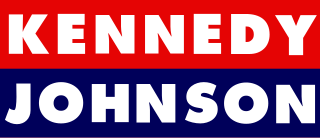
The 1960 presidential campaign of John F. Kennedy, then junior United States senator from Massachusetts, was formally launched on January 2, 1960, as Senator Kennedy announced his intention to seek the Democratic Party nomination for the presidency of the United States in the 1960 presidential election.

The Chicago mayoral election of 1963 was held on April 2, 1963. The election saw Richard J. Daley elected to a third term as mayor, defeating Republican Ben Adamowski by a double-digit margin.

The 1955 Chicago mayoral election saw Democrat Richard J. Daley win election to his first term as mayor by a ten-point margin over Republican Robert E. Merriam. This was the narrowest margin of victory of any of Daley's mayoral races.

The Cook County, Illinois, general election was held on November 8, 2016.
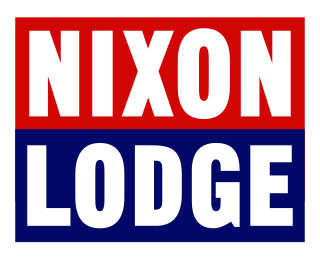
The 1960 presidential campaign of Richard Nixon, the 36th vice president of the United States, under President Dwight D. Eisenhower, began when he announced he was running for the Republican Party's nomination in the 1960 U.S. presidential election on January 9, 1960. He won the Republican primaries with little opposition and chose as his running mate Henry Cabot Lodge Jr., the United States Ambassador to the United Nations. They faced Democrats John F. Kennedy and running mate Lyndon B. Johnson in the general election. The main issues of the election were the civil rights movement, the Cold War, and Kennedy's Catholic faith. Both candidates were against communism, and were in favor of civil rights enough to win Black voters but not enough to lose white southerners.


